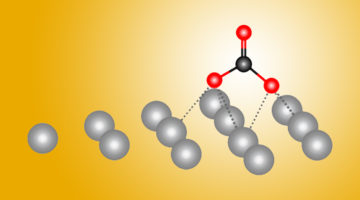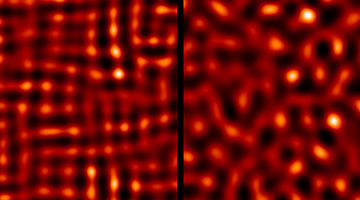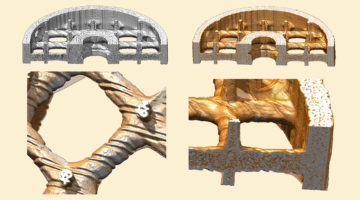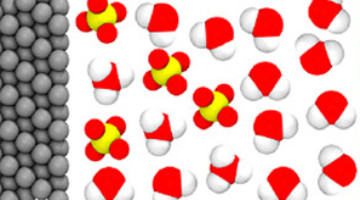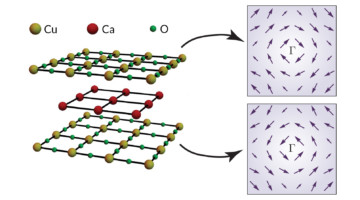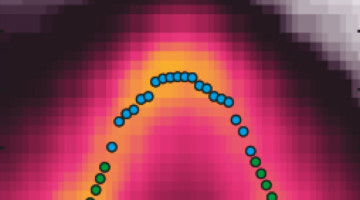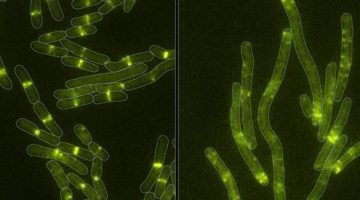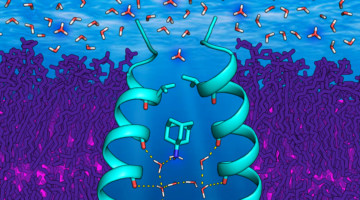Combining ALS experiments with quantum-mechanical calculations, scientists found dramatic differences in how carbon dioxide (CO2) reactions begin on silver as opposed to copper. Both metals help transform CO2—a greenhouse gas—into more useful forms, and this new atomic-level data could help make the process more efficient. Read more »![]()
![]()
Superconductor Exhibits “Glassy” Electronic Phase
Researchers discovered that electrons in a high-temperature superconductor can exhibit a new type of collective behavior that is more “glassy” (disordered) than expected. The study provides valuable insight into the nature of collective electron behaviors and how they relate to high-temperature superconductivity. Read more »![]()
![]()
Antibody Uses Mimicry to Block SARS Coronavirus
Protein structures not only revealed how SARS and MERS antibodies inhibit the viruses from attaching to host cells, they also revealed an unprecedented example of receptor mimicry that triggers the cell-invasion machinery of the SARS virus. The results inform efforts to prevent and treat these serious, often deadly, respiratory diseases. Read more »![]()
![]()
Absorber Captures Excess Chemotherapy Drugs
Researchers have designed a biomedical device for absorbing excess chemotherapy drugs during cancer treatment, characterizing the active surface layer using x-ray microtomography. The work opens up a new route to fighting cancer that minimizes drug toxicity and enables personalized, targeted, high-dose chemotherapy. Read more »![]()
![]()
Reversible Lattice-Oxygen Reactions in Batteries
Researchers quantified a strong, beneficial, and reversible (over hundreds of cycles) chemical reaction involving oxygen ions in the crystal lattice of battery electrode materials. The results open up new ways to explore how to pack more energy into batteries with electrodes made out of low-cost, common materials. Read more »![]()
![]()
Getting to the Bottom of a Metal/Acid Interface
Researchers identified the molecules that collect at the interface between a platinum electrode and an acidic electrolyte under an applied voltage. Knowledge of the structure and composition of such nanometer-thin interface regions is key to understanding topics such as corrosion, geochemistry, electrocatalysis, and energy storage. Read more »![]()
![]()
Spin-Momentum Locking in Cuprate High-Temperature Superconductors
A form of spin-momentum locking, similar to the strong linkage between electron spin and momentum in topological insulators, has been found in a cuprate superconductor. The results open a new chapter in the mystery of high-temperature superconductors, suggesting that new, unexplored interactions and mechanisms might be at play. Read more »![]()
![]()
Electric-Field Switching of Topological Phase
Researchers have successfully switched a topological insulator on and off by applying an electrical field. The work represents a major advancement toward the creation of a functioning topological transistor that would allow devices to operate more efficiently at lower power than conventional electronics. Read more »![]()
![]()
A Two-Pronged Defense against Bacterial Self-Intoxication
Researchers solved the structure of a bacterial toxin bound to a neutralizing protein, revealing two distinct mechanisms for how the toxin-producing bacteria avoid poisoning themselves. The findings offer clues to the evolutionary origins of the potent toxins that enable bacterial pathogens to cause human diseases such as cholera and diphtheria. Read more »![]()
![]()
Toward a Blueprint for Anti-influenza Drugs
Researchers obtained high-resolution structures of several influenza antiviral drug molecules bound to their proton-channel targets in both open and closed conformations. The structures provide an atomic-level blueprint from which to design more effective anti-influenza drugs that can overcome growing drug resistance. Read more »![]()
![]()
